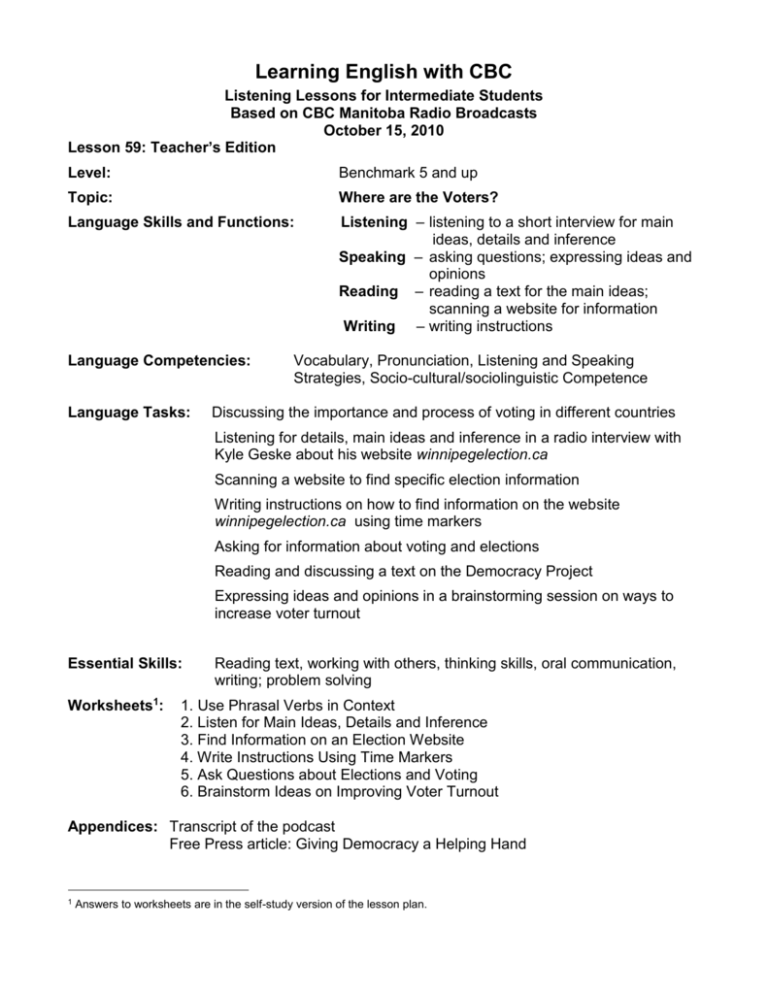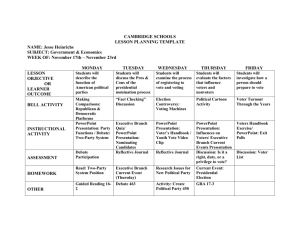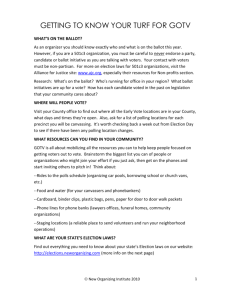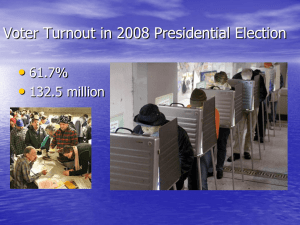WORD
advertisement

Learning English with CBC Listening Lessons for Intermediate Students Based on CBC Manitoba Radio Broadcasts October 15, 2010 Lesson 59: Teacher’s Edition Level: Benchmark 5 and up Topic: Where are the Voters? Language Skills and Functions: Listening – listening to a short interview for main ideas, details and inference Speaking – asking questions; expressing ideas and opinions Reading – reading a text for the main ideas; scanning a website for information Writing – writing instructions Language Competencies: Language Tasks: Vocabulary, Pronunciation, Listening and Speaking Strategies, Socio-cultural/sociolinguistic Competence Discussing the importance and process of voting in different countries Listening for details, main ideas and inference in a radio interview with Kyle Geske about his website winnipegelection.ca Scanning a website to find specific election information Writing instructions on how to find information on the website winnipegelection.ca using time markers Asking for information about voting and elections Reading and discussing a text on the Democracy Project Expressing ideas and opinions in a brainstorming session on ways to increase voter turnout Essential Skills: Worksheets1: Reading text, working with others, thinking skills, oral communication, writing; problem solving 1. Use Phrasal Verbs in Context 2. Listen for Main Ideas, Details and Inference 3. Find Information on an Election Website 4. Write Instructions Using Time Markers 5. Ask Questions about Elections and Voting 6. Brainstorm Ideas on Improving Voter Turnout Appendices: Transcript of the podcast Free Press article: Giving Democracy a Helping Hand 1 Answers to worksheets are in the self-study version of the lesson plan. Manitoba Memo With municipal elections on the horizon in Manitoba, the main question is not only who will win, but how many of us will actually vote? Turnout in local elections tends to be even lower than provincial or federal elections. In 2006, only thirty-nine percent of Winnipeg residents voted to select a mayor, council members and school board trustees. Even though it is not that long ago that major battles were fought to win the right to vote, fewer and fewer people are voting in developed countries around the world. In other parts of the world, the right to vote does not exist, or if it does, it’s not an easy process. We can easily understand the reasons for low voter turnout in fledgling democracies. Line-ups can be very long, polling stations can be disorganized and voters may even be threatened with violence. It is more difficult to understand the reasons why voter turnout is declining in Canada. Here, voting is a relatively simple, safe task. Polling stations stay open long hours. They are conveniently located, well-staffed and well organized. Line-ups are rare. If you can’t vote on election day, there are numerous advance polls. The main challenge voters face is becoming informed about the candidates and their positions on the issues. While the internet is making that task easier, becoming an informed voter does take some time and effort. So why is that fewer and fewer Manitobans and Canadians are voting? There are many hypotheses, including: We’re too busy working and raising our families; We don’t think our vote will make a difference or bring about change; We think we can make more of a difference by working with a non-profit organization than by becoming involved in politics; We don’t understand the issues; We think that all political parties and candidates are basically the same. Are these reasons not to vote valid? Or are they simply excuses? What happens to democracy if voter turnout continues to decline? Or if some demographic groups aren’t fully participating in making the decisions about which candidates and political parties we elect to run our governments? These aren’t only questions for scholars and journalists. They are questions we all need to think about. Where Are the Voters? Learning English with CBC Page 2 of 16 Pre-listening activities 1. Discuss as a class Have you ever voted in an election? Did you vote in your country? What kind of election was it? Was it a local, regional or national election? Have you voted in Canada? In what election(s)? How easy/difficult was it for you vote in your country? Why was it easy/difficult? How did the experience of voting in your country compare to voting in Canada? Do you think people in established democracies like Canada take the right to vote for granted? Is that a problem? If so, why? If not, why not? 2. Vocabulary Elicit or present key vocabulary that students need to understand prior to listening to the podcast (see suggested vocabulary and explanations which follow). You can write the words on the board and elicit possible meanings from the class or break students into groups and give each group a few words to review. Groups can then present the vocabulary to the rest of the class. You can also ask students to mark the syllables and stress for each word, identify word families and practise pronouncing the words. You may want to ask students to think of sentences that use the new vocabulary. If your students keep a vocabulary journal, they can copy the vocabulary into their journal. Vocabulary a democracy A system of government where citizens vote to elect people to represent them. voter turnout The percentage of eligible voters who actually come out and vote in an election. a trend When things develop or change over time. For example, one recent development or trend is for candidates to use Facebook and Twitter to communicate with voters. local elections Elections at the local or municipal level for reeves, mayors, councillors and school trustees. a candidate Someone who competes for a position in an election. an initiative Something a person starts, like a project or plan. user-friendly Something that is easy for everyone to use. You don’t need to be an expert or experienced to use it. a council ward A ward is a geographical area in a city. Councillors run for office to represent people who live in a ward, or specific area of a city. a school trustee A trustee is a person who is elected to represent the interests of voters on the local school board. Where Are the Voters? Learning English with CBC Page 3 of 16 Facebook and Twitter Popular social media websites that are used to connect and communicate with others via the internet. You Tube You Tube is a video sharing website on which users can upload and share videos. a polling station The place where a person goes to cast their ballot and vote in an election. apathy When people are not interested in something, they are often described as being apathetic. For example: Voter apathy or lack of interest in politics may be one reason for low voter turnout rates. Google Google is a way to search the internet to find information. You type the word or subject you are interested in into Google and it finds all the websites with information on your topic. top hits Google’s top hits are the most popular websites on a specific topic. 3. Predict what the interview is about In this story, Marilyn Mackie interviews a Red River College instructor who has cofounded a website called winnipegelection.ca. Ask students if they can predict what kind of information people might find on this website. Here are a few examples: I think people might find ...information on the candidates. The website might have...information on how and where to vote. Perhaps the website has...different people’s opinions on the election. Maybe the website has...a map of the different wards in Winnipeg. I don't know what I would find on that website. I don’t have a clue what kind of information would be on that website. 4. Expand your vocabulary: Phrasal verbs Tell students that the story they are about to hear contains several phrasal verbs. Ask students what they know about phrasal verbs. Can they think of any examples? Hand out Worksheet 1 and review the structure of phrasal verbs and the examples with the class. Ask students to work with a partner to complete the worksheet and take up the answers as a class. Where Are the Voters? Learning English with CBC Page 4 of 16 While-listening activities 1. Introduce the podcast Tell students that in this podcast, they will hear three speakers. They will hear: Marcy Markusa – host Marilyn Mackie – interviewer Kyle Geske – website co-founder Play the podcast for the first time. 2. Listen for main ideas, details and inference Hand out Worksheet 2. Ask students to work with a partner to complete it. Discuss the answers as a class. 3. Pronunciation: “ta” Ask students if they noticed the instances where Kyle reduced the word “to” to “ta” and linked it to the previous word. Write the examples on the board and have students repeat them aloud to hear the difference in pronunciation. Written English Just to provide information Just to put that information up Spoken English Justa provide information Justa put that information up Line 15 20 Tell students there are other instances in the audio where the word “to” on its own is reduced to “ta” (note that Kyle doesn’t use the reduction consistently). Give students a copy of the transcript. Ask them to listen to the audio again and underline examples of when they hear the word “to” pronounced as “ta”. Discuss what students hear as a class. After-listening activities 1. Review pre-listening predictions Ask students whether they were able to correctly what information might be on the website. Where Are the Voters? Learning English with CBC Page 5 of 16 Extension activities 1. Find information on winnipegelection.ca Hand out Worksheet 3 and review it with students. Ask students to work in pairs to complete it. Take up the answers as a class. 2. Write website use instructions for another student using time markers Hand out Worksheet 4 and review the instructions. Have students work with their partner, but each student can write his or her set of instructions. 3. Asking questions about voting and elections Hand out Worksheet 5. Have students work with a partner. Take up the answers as a class. 4. Read a text on the Winnipeg Free Press Democracy Project and brainstorm ideas on how voter turnout could be improved Hand out Appendix 2. Ask students to work in small groups to first read the article. Ask for volunteers to summarize what the Democracy Project is about. Ask students what they think of this initiative. Is it a good idea? A bad idea? Why? Hand out Worksheet 5. Review the instructions with the class. Ask each group to appoint a note keeper and keep track of their ideas. Ask someone from each group to report back to the class. Note: This is an ongoing project with the Free Press. Your class could follow the updates on this story over the several months. Want to know more… The link to the Kyle Geske’s website is: http://winnipegelection.ca/ For a list of about 200 phrasal verbs, go to: http://www.englishclub.com/vocabulary/phrasal-verbs-list.htm For information about voter eligibility and other Winnipeg election information, go to: http://www.winnipeg.ca/clerks/docs/elections/2010election/voter/eligibility.htm For information on elections in other municipalities in Manitoba, go to: http://web5.gov.mb.ca/mfas/mfas_elections.aspx For information on school board elections, go to: http://www.mbschoolboards.ca/ CBC Manitoba has information on the Winnipeg elections on its website: http://www.cbc.ca/manitoba/features/manitobavotes2010/ Information on municipal races outside Winnipeg will be in the local newspapers. CBC does not endorse and is not responsible for the content of external websites Where Are the Voters? Learning English with CBC Page 6 of 16 Worksheet 1: Use Phrasal Verbs in Context Phrasal verbs have two parts, a verb and a particle. Two-part verbs are very common, especially in spoken English. They are a lot like idioms and they can be very confusing to English language learners. This is because it is often difficult to guess the meaning of phrasal verbs even if you know the meaning of both of the parts. In most situations, you need context to help you guess or infer the meaning of the phrasal verb. The information below reviews the structure of phrasal verbs and provides examples of how they are used. phrasal verb = simple verb + particle Examples of particles: in, on, off, up, out, up, over, under, down, after Phrasal verb look + after Meaning Example to take care of look + over to check something, to look at it closely look + out to be careful: to be aware of something that’s about to happen Jose can’t come with us tonight. She has to look after her younger sister. Maria carefully looked over the bill. She checked to make sure the waiter had not charged her too much. The mother warned her children to look out for the car backing up in the parking lot. She wanted to be sure they watched carefully and did not walk behind it. Note: For some phrasal verbs, the particle must directly follow the main verb. They cannot be separated. But other phrasal verbs can be separated. For example, you could say: When the bill came, Maria looked it (the bill) over. In this case, the pronoun “it” separates the two parts of the phrasal verb. Unfortunately, there are no hard and fast rules about which phrasal verbs can be separated and which cannot. Like idioms, phrasal verbs are something we learn through practice. Where Are the Voters? Learning English with CBC Page 7 of 16 Now it’s your turn! The CBC interview you are about to listen to has several phrasal verbs. Read the following summary of the story with your partner. Can you use the context clues provided and fill in the blanks with the correct phrasal verb from the box below? The first one is completed for you as an example. 1. Two teachers from Red River College have set up (started; established) an election website. 2. In the last election, the teachers had difficulty finding information about the candidates running in their area of the city on the internet. So this election, they decided to create a website and________ (display; show) information about the all of the candidates. 3. The teachers hope their website will provide information to voters and this will _________ (cause; lead to) better voter turnout. 4. If you go to Google and ________ (key in) Winnipeg election, you will find the website on the internet. 5. When you ______ (view; observe) the main page of the website, you will see a map. 6. If you ________ (select; choose) a ward on the city map on the website, you will find information about the candidates running for election in that ward. 7. Be sure to _______ (take a look at) this website so you can be an informed voter! click on check out put up type in Where Are the Voters? look at set up result in Learning English with CBC Page 8 of 16 Worksheet 2: Listen for Main Ideas, Details and Inference Sometimes when we listen, we are listening for important details that help us to understand a situation. Sometimes we are listening for the main ideas or for inference. When you listen to the interview this time, listen for main ideas, details and inference. Read the questions with your partner and decide whether the statement is true or false. If the statement is false, can you re-write it to make it true? The first one is completed for you as an example. 1 Sentence Voter turnout is not a problem in Canada. T/F F Rewritten sentence: Voter turnout is a problem in Canada. 2 The decline is significant across all demographic groups. 3 Turnout in local elections is higher than provincial elections. 4 The main purpose of the website is to provide information about the candidates who are running for office in Winnipeg. 5 People who are somewhat familiar with the internet may find the website challenging to navigate. 6 The best way to find information about your area on the website is to click on your ward on the map, or to select your ward from a list. 7 Only candidates with a good chance of winning are included on the website. 8 Kyle Geske believes voters will be more likely to cast a ballot if they know something about the candidates in their area. 9 The website creators are confident their website will result in higher voter turnout. Bonus question: What do you think of this project? Do you think the website will have the impact the teachers are hoping it will have? Why or why not? Where Are the Voters? Learning English with CBC Page 9 of 16 Worksheet 3: Find Information on the winnipegelection.ca Website More and more people look for information they need on the internet. Whether you need to find information for school, for work or for your family, the internet is often the easiest place to start your search. Can you find the information you are looking for on a website? Work with your partner to see if you can find the answers to the following questions on winnipegelection.ca. by following the steps on this worksheet. 1. Type Winnipeg election into Google or whatever search engine you are using. Click on the website winnipegelection.ca. 2. Look at the website Home Page. How many days are left until the election takes place? Your answer: ______________ 3. Open up the Calendar Page. Click on month. Scan the calendar. What was the date of the CBC Manitoba/ Winnipeg Free Press debate? Your answer: ______________ 4. Return to the website Home Page. Click on Mayoral Candidates. How many candidates are running for Mayor of Winnipeg? Your answer: ______________ 5. Now you are going to help your friend Ilona. She wants to know who is running for city council in her Ward. She lives at 440 Dominion Street. Click on More election information? on the website Home Page. Click on Find Your Ward. Click on the city of Winnipeg’s address look-up tool. Type in Ilona’s address. (Abbreviations you need to know: Street is St, Number is Num). Click on search. 6. What is the name of the Council Ward Ilona lives in? Your answer: ______________ 7. Return to the website Home Page. Click on Ilona’s Ward on the map. Can you tell Ilona how many people are running for council in her ward? Your answer: ______________ Where Are the Voters? Learning English with CBC Page 10 of 16 Worksheet 4: Write Instructions on How to Use the Website Using Time Markers Now that you have used the winnipegelection.ca website to find information, can you write instructions in your own words to help another student use the website? Your friend Carlos wants to know how to find his Ward on the website and how to find out who is running for council in his Ward. Carlos’ address is 1455 Henderson Highway (hwy). Can you write instructions for Carlos similar to those you used to find this information for Ilona? Using the following time markers will to help you write your instructions and make the process Carlos needs to follow very clear. The first instruction is completed for you as an example: Last Next* First After that* Then* Second 1. First, type Winnipeg election into Google and click on the website winnipegelection.ca. 2. ___________, ___________________________________________________________ 3. ___________, ___________________________________________________________ 4. ___________, ___________________________________________________________ 5. ___________, ___________________________________________________________ 6. ___________, ___________________________________________________________ Practice saying your instructions out loud to each other when you finish writing them down. Or have your partner follow your instructions on the website as you read them to see if they work! * You will sometimes see this symbol, called an asterisk, in a document. It functions like a footnote. It draws your attention to certain words or information because the author wants to tell you something more about them. In this case, next, after that and then are followed by an * (asterisk) to let you know that these three time markers can be used interchangeably. In other words, you can use them for numbers 3, 4 or 5 on your instruction list. Where Are the Voters? Learning English with CBC Page 11 of 16 Worksheet 5: Asking Questions About Voting and Elections Voters, especially first-time voters, often have many questions about the voting process. Can you ask the questions you might need to find out this kind of information? Practice asking the following questions with your partner. You can make notes or write the question first if that helps you. The first one is completed for you as an example. Questions 1. You want to know the date of the election. What is the date of the election? 2. You want to know who is eligible to vote in the election. _______________________________________________________________ 3. You want to know how to get your name on the voters list. _______________________________________________________________ 4. You want to know where you go to vote on election day. _______________________________________________________________ 5. You want to know what identification you need to take with you to the polling station. _______________________________________________________________ 6. You want to know if the polling station is wheelchair accessible. _______________________________________________________________ 7. You want to know where you can find out information about the candidates running in your area. _______________________________________________________________ Where Are the Voters? Learning English with CBC Page 12 of 16 Worksheet 6: Brainstorming Ideas on Improving Voter Turnout You and your group have read the Winnipeg Free Press article about the Democracy Project. Clearly, the decline in voter turnout is a big problem. How can it be solved? The Free Press is looking to Manitobans for ideas. One way to problem solve is to brainstorm possible ideas and solutions. Brainstorming is a way to quickly discuss and list ideas. Brainstorming is often used by employers as a creative way to solve a problem in the workplace. There are four main principles to keep in mind when you are brainstorming: 1. Participants accept and do not judge each other’s ideas (all ideas are considered equal); 2. Lots of different ideas are offered; 3. Creative thinking (often called thinking outside-the-box) is encouraged; 4. Ideas may be combined to form new ideas. Work in your group to brainstorm ideas and solutions for this question. Appoint a notetaker to write your group’s ideas below and on the back of this page, or use a flip chart. 1. What kinds of things do you think might encourage newcomers and other low turnout groups to become interested in the next provincial election and come out to vote? ______________________________________ ______________________________________ ______________________________________ ______________________________________ ______________________________________ ______________________________________ ______________________________________ ______________________________________ ______________________________________ Where Are the Voters? Learning English with CBC Page 13 of 16 Appendix 1: Transcript October 4, 2010 (broadcast date) Speaker Podcast Line Marcy Hi I'm Marcy Markusa and you're listening to Learning English 1 with CBC. Well there is a lot of talk in democratic societies about voter turnout. The Canadian trend is that some demographic groups, including youth, newcomers, women and First Nations people, are less likely to vote. But no-one knows 5 exactly why. Turnout in local elections, like the one we are having this fall in Winnipeg, tends to be the lowest of all. Two Red River College instructors are making it easier for Winnipeg residents to become informed about local candidates with a new website. Radio noon host Marilyn Mackie interviewed Kyle 10 Geske, one of the teachers behind this initiative, to find out more. Marilyn I went and looked at your website so tell me why did you set up an election website? Kyle We set up one justa, justa provide information. We ah we were 15 sorta concerned about the voter turnout last time around, as you said, it was ah, I think, somewhere around 39 percent and um in our minds, like we tend to go to the internet for information and last time around we couldn’t find ah all that much information about the election or the candidates ah so we decided justa put 20 that information up ourselves. Marilyn Okay, so tell me how it’s set up. It’s fairly ah user-friendly? Kyle It’s fairly user-friendly, you come into to the site and you can pick your council ward via a map or just by name and ah when you click on a particular ward whether it’s a ah council ward or a 25 school trustee ward it brings up a list of all the candidates in that ward, it also shows images ah if the candidate has sent us in their photos, they’re available, and it links to candidate websites, their email addresses, their Facebook pages, Twitter feeds, and even if they have videos up on. Where Are the Voters? Learning English with CBC 30 Page 14 of 16 Marilyn Kyle, do you think having a website like this will result in better voter turnout, any idea? Kyle I would really like to think that if we see an increase in voter turnout that ah we had something to do with that. It’s gonna be very hard to tell if we did but ah when I speak to people one of 35 the things they tell me about ah perhaps why they don’t vote is because of a lack of information. They feel uncomfortable getting to the polling station and, you know, do they just vote for someone whose signs they’ve seen the most? How do they inform themselves about the different candidates? So they were, 40 well I’ve had a lot of people tell me that their sort of voter apathy is tied directly to not knowing enough about the candidates. Marilyn Okay, so what is the website? Let’s get it out there so people can go check it out. Kyle The website is winnipegelection.ca. And ah if you go into Google and you just type in Winnipeg election you should find us as one of the top hits. Where Are the Voters? Learning English with CBC Page 15 of 16 45 Appendix 2: Winnipeg Free Press Story Giving democracy a helping hand2 Free Press launches project to get more voters out to 2011 election By: Margo Goodhand, Winnipeg Free Press Posted: 2/10/2010 1:00 AM We're kicking off a year-long project today with one simple objective. We want more Manitobans to vote in the Oct. 4, 2011 provincial election. It's a simple goal but not a simple task. Voter turnout is declining across the developed world. In 2008 for the first time in Canadian history, the federal electoral turnout dropped below 60 per cent. And here in Manitoba -- where our women were the first in Canada to win the right to vote 94 years ago -- we now have one of the lowest voter turnouts of the nation. Why? We're going to find out. And we hope to make it change. We call it the Democracy Project. Over the next 12 months, we will examine issues and ideologies beyond the politicians and their campaigns. We want to know what you care about and how to make your ballot count. We hope to talk to many of you over the next year -- from our youngest citizens, who are voting in increasingly smaller numbers than their parents and grandparents; to our newest citizens, who often feel disengaged from the process in their adopted homeland; to our aboriginal community, of which so many are both young and disengaged. You can follow the Democracy Project in the paper and online. Or join in on the year-long dialogue on Facebook. Manitoba women fought hard for women's suffrage at the turn of the 20th century. Today, thousands of us don't even bother to cast a ballot. We hope to remind ourselves why that fundamental right was so important then, and now. 2 http://www.winnipegfreepress.com/breakingnews/giving-democracy-a-helping-hand-104199839.html Where Are the Voters? Learning English with CBC Page 16 of 16








